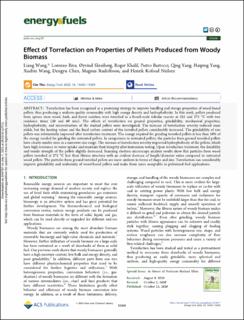| dc.description.abstract | Torrefaction has been recognized as a promising strategy to improve handling and storage properties of wood-based pellets, thus producing a uniform-quality commodity with high energy density and hydrophobicity. In this work, pellets produced from spruce stem wood, bark, and forest residues were torrefied in a bench-scale tubular reactor at 225 and 275 °C with two residence times (30 and 60 min). The effects of torrefaction on general properties, grindability, mechanical properties, hydrophobicity, and microstructure of the studied pellets were investigated. The increase of torrefaction severity reduced mass yields, but the heating values and the fixed carbon content of the torrefied pellets considerably increased. The grindability of raw pellets was substantially improved after torrefaction treatment. The energy required for grinding torrefied pellets is less than 50% of the energy needed for grinding the untreated pellets. In comparison to untreated pellets, the particles from ground torrefied pellets have clearly smaller sizes in a narrower size range. The increase of torrefaction severity improved hydrophobicity of the pellets, which have high resistance to water uptake and maintain their integrity after immersion testing. Upon torrefaction treatment, the durability and tensile strength of the pellets slightly decreased. Scanning electron microscopy analysis results show that particles from wood pellets torrefied at 275 °C lost their fibrous structure with an evident decrease of length/diameter ratios compared to untreated wood pellets. The particles from ground torrefied pellets are more uniform in terms of shape and size. Torrefaction can considerably improve grindability and uniformity of wood-based pellets and make them more acceptable in pulverized fuel applications. Wood,Biomass,Energy,Durability,Materials | en_US |

